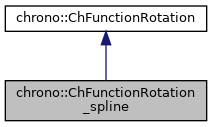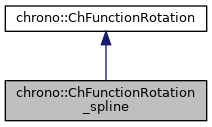Description
A rotation function q=f(s) that interpolates n rotations using a "quaternion spline" of generic order.
For order 1 (linear) this boils down to a classical SLERP interpolation. For higher orders, this operates as in the paper "A C^2-continuous B-spline quaternion curve interpolating a given sequence of solid orientations", Myoung-Jun Kim, Myung-Soo Kim. 1995. DOI:10.1109/CA.1995.393545. Note, except for order 1 (linear) the rotation does not pass through control points, just like for positions in Bspline, except for first and last point. Exact interpolation requires the 'inversion' of the control points (to do).
#include <ChFunctionRotation_spline.h>


Public Member Functions | |
| ChFunctionRotation_spline () | |
| Constructor. By default constructs a linear SLERP between two identical null rotations. | |
| ChFunctionRotation_spline (int morder, const std::vector< ChQuaternion<> > &mrotations, ChVectorDynamic<> *mknots=0) | |
| Constructor from a given array of control points; each control point is a rotation to interpolate. More... | |
| ChFunctionRotation_spline (const ChFunctionRotation_spline &other) | |
| virtual ChFunctionRotation_spline * | Clone () const override |
| "Virtual" copy constructor. | |
| double | ComputeUfromKnotU (double u) const |
| When using Evaluate() etc. More... | |
| double | ComputeKnotUfromU (double U) const |
| When using Evaluate() etc. More... | |
| std::vector< ChQuaternion<> > & | Rotations () |
| Access the rotations, ie. quaternion spline control points. | |
| ChVectorDynamic & | Knots () |
| Access the knots. | |
| int | GetOrder () |
| Get the order of spline. | |
| virtual void | SetupData (int morder, const std::vector< ChQuaternion<> > &mrotations, ChVectorDynamic<> *mknots=0) |
| Initial easy setup from a given array of rotations (quaternion spline control points). More... | |
| std::shared_ptr< ChFunction > | GetSpaceFunction () const |
| Gets the address of the function u=u(s) telling how the curvilinear parameter u of the spline changes in s (time). | |
| void | SetSpaceFunction (std::shared_ptr< ChFunction > m_funct) |
| Sets the function u=u(s) telling how the curvilinear parameter of the spline changes in s (time). More... | |
| void | SetClosed (bool mc) |
| Set as closed periodic spline: start and end rotations will match at 0 and 1 abscyssa as q(0)=q(1), and the Evaluate() and GetTangent() functions will operate in periodic way (abscyssa greater than 1 or smaller than 0 will wrap to 0..1 range). More... | |
| bool | GetClosed () |
| Tell if the rotation spline is closed periodic. | |
| virtual ChQuaternion | Get_q (double s) const override |
| Return the q value of the function, at s, as q=f(s). More... | |
| virtual void | ArchiveOut (ChArchiveOut &marchive) override |
| Return the derivative of the rotation function, at s, expressed as angular velocity w in local frame. More... | |
| virtual void | ArchiveIn (ChArchiveIn &marchive) override |
| Method to allow de-serialization of transient data from archives. | |
 Public Member Functions inherited from chrono::ChFunctionRotation Public Member Functions inherited from chrono::ChFunctionRotation | |
| ChFunctionRotation (const ChFunctionRotation &other) | |
| virtual ChVector | Get_w_loc (double s) const |
| Return the derivative of the rotation function, at s, expressed as angular velocity w in local frame. More... | |
| virtual ChVector | Get_a_loc (double s) const |
| Return the derivative of the rotation function, at s, expressed as angular acceleration in local frame. More... | |
| virtual void | Estimate_s_domain (double &smin, double &smax) const |
| Return an estimate of the domain of the function argument. More... | |
| virtual void | Update (double t) |
| Update could be implemented by children classes, ex. to launch callbacks. | |
Constructor & Destructor Documentation
◆ ChFunctionRotation_spline()
| chrono::ChFunctionRotation_spline::ChFunctionRotation_spline | ( | int | morder, |
| const std::vector< ChQuaternion<> > & | mrotations, | ||
| ChVectorDynamic<> * | mknots = 0 |
||
| ) |
Constructor from a given array of control points; each control point is a rotation to interpolate.
Input data is copied. If the knots are not provided, a uniformly spaced knot vector is made.
- Parameters
-
morder order p: 1= linear, 2=quadratic, etc. mrotations control points, size n. Each is a rotation. Required: at least n >= p+1 mknots knots, size k. Required k=n+p+1. If not provided, initialized to uniform.
Member Function Documentation
◆ ArchiveOut()
|
overridevirtual |
Return the derivative of the rotation function, at s, expressed as angular velocity w in local frame.
Return the derivative of the rotation function, at s, expressed as angular acceleration in local frame. Method to allow serialization of transient data to archives
Reimplemented from chrono::ChFunctionRotation.
◆ ComputeKnotUfromU()
|
inline |
When using Evaluate() etc.
you need U parameter to be in 0..1 range, but knot range is not necessarily in 0..1. So you can convert U->u, where u is in knot range, calling this:
◆ ComputeUfromKnotU()
|
inline |
When using Evaluate() etc.
you need U parameter to be in 0..1 range, but knot range is not necessarily in 0..1. So you can convert u->U, where u is in knot range, calling this:
◆ Get_q()
|
overridevirtual |
Return the q value of the function, at s, as q=f(s).
Parameter s always work in 0..1 range, even if knots are not in 0..1 range. So if you want to use s in knot range, use ComputeUfromKnotU().
Implements chrono::ChFunctionRotation.
◆ SetClosed()
| void chrono::ChFunctionRotation_spline::SetClosed | ( | bool | mc | ) |
Set as closed periodic spline: start and end rotations will match at 0 and 1 abscyssa as q(0)=q(1), and the Evaluate() and GetTangent() functions will operate in periodic way (abscyssa greater than 1 or smaller than 0 will wrap to 0..1 range).
The closure will change the knot vector (multiple start end knots will be lost) and will create auxiliary p control points at the end that will be wrapped to the beginning control points.
◆ SetSpaceFunction()
|
inline |
Sets the function u=u(s) telling how the curvilinear parameter of the spline changes in s (time).
Otherwise, by default, is a linear ramp, so evaluates the spline from begin at s=0 to end at s=1
◆ SetupData()
|
virtual |
Initial easy setup from a given array of rotations (quaternion spline control points).
Input data is copied. If the knots are not provided, a uniformly spaced knot vector is made.
- Parameters
-
morder order p: 1= linear, 2=quadratic, etc. mrotations rotations, size n. Required: at least n >= p+1 mknots knots, size k. Required k=n+p+1. If not provided, initialized to uniform.
The documentation for this class was generated from the following files:
- /builds/uwsbel/chrono/src/chrono/motion_functions/ChFunctionRotation_spline.h
- /builds/uwsbel/chrono/src/chrono/motion_functions/ChFunctionRotation_spline.cpp
